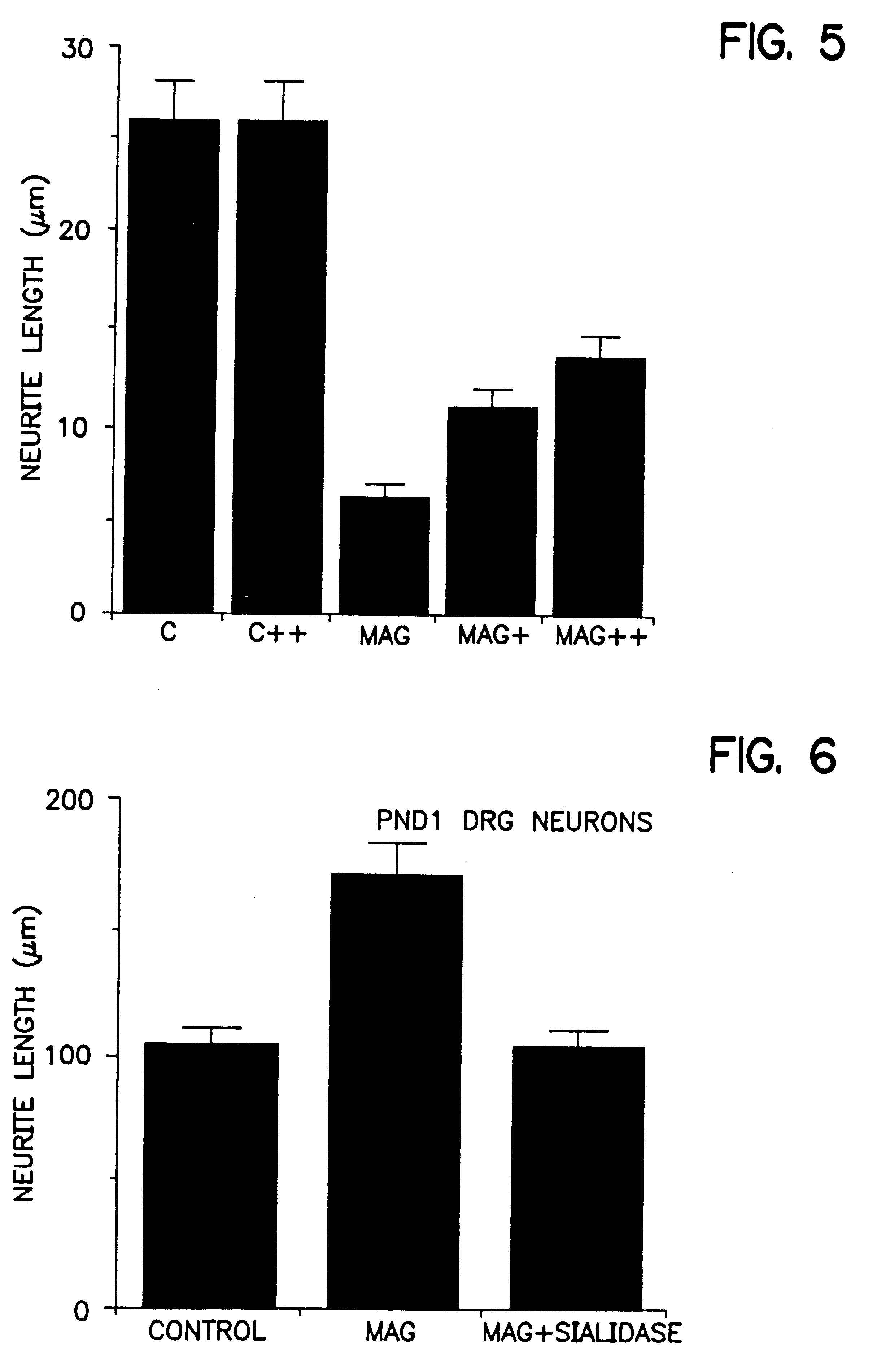Compositions and methods using myelin-associated glycoprotein (MAG) and inhibitors thereof
a glycoprotein and myelin technology, applied in the field of myelin-associated glycoproteins and inhibitors, can solve the problems of inability to predict the component of the neuron that the putative inhibitory molecules are, unfavorable contribution to the lack of neural regeneration after injury, and inability to logically design strategies to prevent the blockage of these molecules from inhibiting neural regeneration
- Summary
- Abstract
- Description
- Claims
- Application Information
AI Technical Summary
Problems solved by technology
Method used
Image
Examples
example 1
Isolation of Different Neuronal Cell Types
Neurons were isolated essentially as described in Doherty et al., Nature, 343, pp. 464-66 (1990); Neuron, 5, pp. 209-19 (1990); and Kleitman et al., Culturing Nerve Cells, pp. 337-78, MIT Press, Cambridge, Mass. / London, England (G. Banker and K. Goslin, Eds.) (1991). Briefly, for animals up to nine days of age, the cerebellum, retina, hippocampus, and spinal cord were removed from two animals. Like tissue was combined and placed in 5 ml of 0.025% trypsin in PBS, triturated, and incubated for a further 10 minutes (min.) at 37.degree. C. Trypsinization was stopped by addition of 5 ml DMEM containing 10% fetal calf serum (FCS) and cells were centrifuged at 800 rpm for 6 min. The cells were resuspended to a single cell suspension in 2 ml of SATO containing 2% FCS. For DRG and SCG neurons, ganglia were removed from two animals and incubated in 5 ml of L15 medium containing 0.025% trypsin and 0.3% collagenase type I (Worthington) for 30 min. at 37...
example 2
Neurite Outgrowth Assays on Transfected CHO Cells
Expression of MAG by Transfected CHO Cells
Chinese hamster ovary (CHO) cells deficient in the dihydrofolate reductase (dhfr) gene (Urlaub and Chasin, Proc. Natl. Acad. Sci. USA, 77,pp. 4216-20 (1980)) were transfected with a MAG-cDNA expression plasmid with the dhfr gene and the L-MAG cDNA in either a 5'-3' or, as a control, a 3'-5' orientation, cells with multiple copies of dhfr were selected by growing in increasing concentrations of methotrexate, and the expression of MAG by individual transfected CHO cell lines characterized as described in Mukhopadhyay et al., Neuron, 13,pp. 757-67 (1994), which is incorporated herein by reference. Transfected cells were maintained in DMEM supplemented with 10% dialyzed FCS, proline (40 mg / liter), thymidine (0.73 mg / liter), and glycine (7.5 mg / liter) at 37.degree. C. in 5% CO.sub.2.
The MAG-expressing transfected CHO cell line ("CHO-MAG2") described as MAG2 in that publication was deposited on Jun....
example 3
Neurite Growth Assays with CHO Cells to Test Putative RAG-dependent Neurite Growth Altering Agents
The transfected CHO cell assay described in Example 2 may also be used to screen and identify agents that alter neurite growth properties of a particular neuronal cell type and age in a MAG-dependent fashion. Neurite outgrowth was compared for cerebellar (TABLE 1) and DRG (TABLE 2) neurons from PND 2 animals, grown on MAG-expressing and control CHO cells as described in Example 2. Where indicated, small sialic acid-bearing sugars were included in the co-cultures at increasing concentrations. 100% inhibition was taken as the difference in length of neurites on control and MAG-expressing CHO cells. Results are the mean of at least two experiments, with at least 150 neurons measured for each experiment. DD-NANA=2,3-dideoxy sialic acid; SL=sialo 2,3-.alpha. lactose.
This assay may be used to test other putative MAG-dependent neurite growth regulating agents by including them in the coculture...
PUM
| Property | Measurement | Unit |
|---|---|---|
| concentration | aaaaa | aaaaa |
| concentration | aaaaa | aaaaa |
| volume | aaaaa | aaaaa |
Abstract
Description
Claims
Application Information
 Login to View More
Login to View More - R&D
- Intellectual Property
- Life Sciences
- Materials
- Tech Scout
- Unparalleled Data Quality
- Higher Quality Content
- 60% Fewer Hallucinations
Browse by: Latest US Patents, China's latest patents, Technical Efficacy Thesaurus, Application Domain, Technology Topic, Popular Technical Reports.
© 2025 PatSnap. All rights reserved.Legal|Privacy policy|Modern Slavery Act Transparency Statement|Sitemap|About US| Contact US: help@patsnap.com



